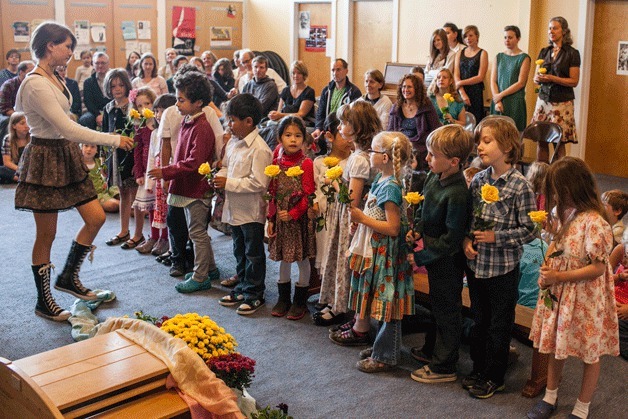It began about 15 years ago as little more than a group of passionate parents, a dozen students and the vision for an alternative style of education on the island.
Madrona School, the dark-green, two-story building standing at Madison Avenue and Bjune Drive, used to include one small classroom in the next-door Eagle Harbor Congregational Church. Now with nine classrooms there and a spacious playground, the Madrona School will enroll approximately 130 students in the 2013-2014 year from preschool through eighth grade.
“It was really founded out of this sense of longing and passion for a style of education that we couldn’t find anywhere else on the island,” said Head of School Missi Goss.
That education is called Waldorf.
Began by Austrian Renaissance man Rudolph Steiner in 1919 at the Waldorf Cigarette Factory, Waldorf education was an experiment in a kind of education that would promote social responsibility and compassion.
Children of the factory workers, boys and girls alike, sons and daughters of both factory workers and managers, learned alongside each other in Steiner’s attempt to create a new type of learning to combat the perils of his day.
learning to combat the perils of his day.
“He was very concerned about the social disintegration that he observed in Europe in the aftermath of World War I,” Goss said.
Goss described the Waldorf philosophy as “a well-balanced, well-grounded education that encompasses a lot of different kinds of activities in additional to conventional academic learning.”
“The purpose in doing all of this is really creating a learning environment that’s a joyful place for children to be,” she said.
As part of that, the curriculum at Waldorf schools across the country and the world embodies the philosophy of “learning through doing and learning though moving,” Goss explained.
Music, the arts and nature play key roles to help students in “exercising their mental capacities in a rigorous, vigorous kind of way.”
Every child takes up knitting in first grade, reads music from notation in fourth, learns botany in fifth, and recounts Arthurian legends in seventh, as part of a well-structured curriculum.
Every child learns two foreign languages beginning in first grade, which at Madrona is Spanish, and coming this year, Swedish. (Madrona previously offered Japanese.)
At Madrona, students learn a stringed instrument in fourth grade and participate in class plays every year, which each time gain more theatrical complexity.
“I think one of the things Madrona School does best for its students is to foster in them this sense in themselves that they are capable of doing and trying lots and lots of different kinds of things,” Goss said.
In order to offer that kind of education to more students, Madrona, as a tuition-based independent school, relies on outside funding, including help from One Call for All.
“With the money that channels to us through One Call, we are able to offer scholarships to students who otherwise we wouldn’t be able to serve,” Goss said.
“It’s really important to both raising money for the school and also for providing visibility as well. We want people to know that we’re here and available to them and being part of One Call allows us to do that.”
And it also helps Madrona continue its mission of providing students with a well-balanced, Waldorf education.
“I believe that’s one of the greatest gifts that we offer to our kids,” Goss said, “is that they have this tremendous breadth of experience and skills and capacities that they can draw on in the future both in terms of their academic accomplishments but even beyond that, their sense of personal satisfaction for themselves in their lives.”


